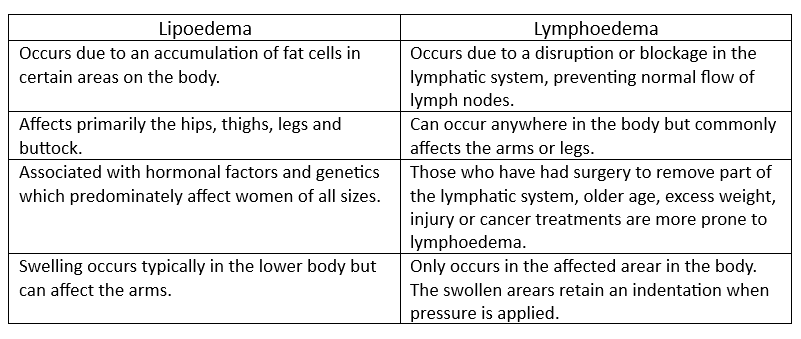Lipoedema and Lymphoedema + How Allied Health Can Help
Lipoedema and Lymphoedema – What is it?
They sound similar but are completely different. Today let our Dietitians and Exercise Physiologists at Healthy Lifestyles Australia take you through the difference between Lipoedema and Lymphoedema and what role nutrition and exercise play.
What is Lipoedema?
Lipoedema is a chronic condition characterized by an abnormal and usually symmetrical accumulation of fat cells, primarily occurring in the lower body such as hips, thighs, legs and buttocks. It typically affects women of all sizes although it can occur in men as well.
The excess fat accumulation occurs beneath the skin, leading to an inconsistent distribution of fat. This results in a distinct body shape with larger proportions in the affected arrears. Apart from the physical appearance, lipoedema causes tenderness, pain, bruising and sensitivity to touch.
What is Lymphoedema?
Lymphoedema is a medical condition that occurs when the lymphatic system is unable to function properly due to damage or a blockage to the lymphatic vessels, which prevent normal flow of lymph nodes and results in swelling in the body.
The lymphatic system consists of a network of vessels and lymph nodes that carry a clear fluid called lymph throughout the body. The system is responsible for maintaining the fluid balance in the body and fighting infections. Therefore, when it becomes damaged, lymphoedema can occur.
What is the difference between them?
How can a Dietician help?
At Healthy Lifestyles Australia, our Dietitian can play a supportive role in helping those with lipoedema by providing guidance and strategies in managing overall health and body fat percentage. Although lipoedema fat is usually resistant to traditional weight loss methods, there are still several ways for it to be managed.
Our Dietitians can provide nutritional education regarding balanced and healthy eating habits, implement body fat management by minimizing additional weight gain using portion control, mindful eating, meal planning and assisting with body fat release when needed. They will further tailor a nutrition protocol individualised for you to help reduce inflammation by recommending an anti-inflammatory nutrition approach that includes nutrients and foods rich in antioxidants and other anti-inflammatory properties. Our Dietitians can provide guidance on managing fluid balance to minimize swelling and fluid retention and can also be a support and provide guidance.
Our Dieticians can provide valuable support and guidance to those with lymphoedema by providing guidance and strategies in managing and understanding their overall health and weight. Many ways our dietitians can help is to explain the importance of sodium management and provide practical tips to reduce sodium in their diet, develop a personalised nutrient-rich meal plan that supports overall health and immune function, manage weight and provide guidance on portion control and balanced eating and meal planning, and help individuals develop a healthy relationship with food.
How can an Exercise Physiologist help?
Our Exercise Physiologist’s at Healthy Lifestyles Australia can play a valuable role in helping those with lipoedema and lymphoedema by designing and implementing an appropriate exercise program personalised to the unique challenges and considerations associated with the individuals conditions, educate and provide lifestyle changes that support the overall well-being of the individual, monitor progress and make adjustments to the treatment plan over time and conduct a range of stimulations and exercises that stimulate the lymphatic system, promote lymphatic flow and reduce swelling associated with lymphoedema. This includes:
o Lymphatic System Stimulation,
o Low-Impact and Joint Friendly exercises
o Strength training and resistance exercises
o Flexibility and range of motion exercises
The Exercise Physiologist for Lipoedema will be able to create an exercise program that is able to work on improving the ratio of muscle to fat in the affected limbs to assist with symptom management. They will also be able to observe you perform those exercises and assist with technique modification to make sure you can complete the program as intended for best benefit.
References
Australasian Lymphology Association. (2021). Retrieved from What is lymphoedema?: https://www.lymphoedema.org.au/about-lymphoedema/what-is-lymphoedema/
Victoria State Government. (2021). Better Health Channel. Retrieved from Lipoedema: https://www.betterhealth.vic.gov.au/health/conditionsandtreatments/Lipoedema#bhc-content


